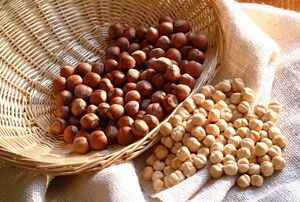
IGP Nocciola di Giffoni is an Italian medium-sized hazelnut, with a diameter not less than 18 mm, subspherical in shape. Chestnut-brown shell with darker stripes. Kernel subspherical in shape, with a diameter not less than 13 mm. Flesh of the kernel white in colour, firm and highly aromatic.
GEOGRAPHICAL AREA: Communes of: GifFoni Valle Piana, Giffoni sei Casali, San Cipriano Picentino, Pisciano, Galvanico, Castiglione dei Genovesi, Montecorvino Rovella. In part the communes of: Baronissi, Montecorvino Pugliano, Olevano sul Tusciano, San Mango Piemonte, Acerno.
HISTORY AND ORIGIN OF THE PRODUCT: Campania is believed to be the first place in Italy where hazelnuts were cultivated: this is shown by the fact that when the ancient Latin writers refer to this plant they almost always mention the Campania region. Moreover, the very name "Avellana", taken by Linnaeus from the old names, is etymologically derived from the name of a very old town in Campania, called Abella. Already at the end of the 18th century the GifFoni area was known as an area growing hazelnuts - a plant which grew there wild and which it was considered necessary to spread more widely. In the course of the last century the spread of hazelnuts cultivation in the GifFoni area was aided by the excellent morphological and organoleptic characteristics which led to great demand from the confectionery industry.
METHOD OF PRODUCTION: The environmental conditions of cultivation of the hazel groves intended for production of "Nocciola di Giffoni" must be the traditional ones of the area and yet be able to give the product its specific quality characteristics. The planting arrangements, shapes in which the trees are trained, and pruning systems must be those in general use, with a density of not more than 660 plants per hectare and shapes consisting essentially of the "many-stemmed", "shrubby" and "small standard" type. "Y" shapes and "hedge" shapes are also allowed, provided that the specific quality characteristics are maintained and the number of plants per hectare does not exceed 1000. The maximum yield allowed is 4000 kg per hectare on specialised plantations.
LINK WITH THE GEOGRAPHICAL ENVIRONMENT: The requirements for "Nocciola di GifFoni" depend on the environmental conditions and on natural and human factors that are typical of the production zone. In particular, a local biotype of hazel is used which has enhanced characteristics in the presence of the climatic factors that are typical of the demarcated area located in hazelnut-growing districts of the Campania region. The "Tonda di Giffoni" variety finds a favourable environment in this zone, since the volcanic soil is very fertile.
Reference: The European Commission
#hazelnut #nutsgrainsandseeds